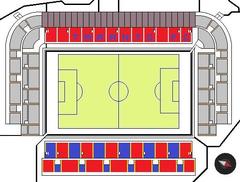Taranto Railway Station Visiting Hours, Tickets, and Travel Guide
Date: 15/06/2025
Introduction: The Significance of Taranto Railway Station
Located in the heart of southern Italy’s Apulia region, Taranto Railway Station (Stazione di Taranto) is both a vital transportation hub and a historical landmark. Established in the late 19th century, it has played a central role in Taranto’s industrial and cultural evolution, linking the city’s bustling port and naval base with the rest of Italy. Its strategic location near Ponte di Porta Napoli and the medieval Borgo Antico allows visitors easy access to Taranto’s most iconic sites, including the Aragonese Castle and the National Archaeological Museum.
This comprehensive guide provides all the essential information for travelers: from visiting hours and ticketing options to accessibility features, train services, and nearby points of interest. Whether you are passing through Taranto or beginning your journey here, you’ll find practical tips and historical insights to enrich your travel experience. For up-to-date travel information, refer to the Trenitalia website and Port of Taranto infrastructure updates. Discover the charm and convenience of one of southern Italy’s most important railway stations (Wikipedia - Stazione di Taranto).
Contents Overview
- Introduction
- Historical Overview of Taranto Railway Station
- Practical Visitor Information
- Train Services and Connectivity
- Role in Urban Regeneration and Sustainable Mobility
- Visitor Tips and Essential Information
- Frequently Asked Questions (FAQ)
- Visual Highlights
- Conclusion
- Sources
Historical Overview of Taranto Railway Station
Origins and Early Importance
Taranto Railway Station was inaugurated in the late 19th century, quickly becoming the primary hub for both passenger and freight traffic in the region. Its proximity to Taranto’s port and naval facilities was crucial for moving goods and people throughout southern Italy and across the Adriatic and Tyrrhenian seas (Wikipedia - Stazione di Taranto). Initially managed by the Rete Adriatica and Rete Mediterranea, the station was instrumental in transporting agricultural products and timber. Despite shifts in freight traffic after the opening of the Ferrovia Tirrenica Meridionale, Taranto retained its strategic importance.
Expansion and Modernization
In the 20th century, the station expanded thanks to the Ferrovie del Sud Est, connecting Taranto to other key towns like Martina Franca and the Valle d’Itria. The city’s industrial growth, particularly the establishment of the Ilva steelworks, drove further infrastructural improvements to accommodate increasing passenger and freight demands (Rough Guides - Taranto).
Strategic Role in Port and Naval Operations
The station’s integration with port and naval operations facilitated the efficient movement of goods and played a critical role during Italy’s military engagements in the 20th century. Its logistical significance made it a vital hub for troop and equipment transfers (Facts.net - Taranto).
Modern Upgrades and Infrastructure Projects
The 21st century brought significant upgrades, including electrified tracks and a new logistics terminal at the former S. Nicola station. These enhancements improve both freight and passenger connectivity with the wider national rail network (Port of Taranto - Infrastructure Works).
Architectural and Cultural Context
Set near the historic Ponte di Porta Napoli and Borgo Antico, the station is a crossroads of Taranto’s industrial and historical identity. Its location enables effortless exploration of the city’s rich cultural landmarks (Rough Guides - Taranto).
Role in Regional and National Rail Networks
Today, Taranto Centrale links the city with Rome, Naples, Bari, Lecce, and more, integrating seamlessly with local bus and taxi services (ItaliaTren - Taranto).
Practical Visitor Information
Visiting Hours
The station is open daily from 5:00 AM to 11:00 PM. Ticket offices generally operate from 6:00 AM to 8:00 PM, but times may vary during holidays or special events. Always check the Trenitalia website for the most current information.
Tickets
Tickets can be purchased at staffed ticket counters, self-service machines, or online via Trenitalia and other authorized platforms. Regional tickets to destinations like Bari or Lecce are affordable, with discounts available for children, seniors, and groups. Remember to validate paper tickets at the yellow machines before boarding.
Accessibility
The station has been upgraded for accessibility, featuring ramps, elevators, tactile paving, accessible restrooms, and dedicated parking. Staff assistance is available upon request.
Facilities and Amenities
- Climate-controlled waiting areas
- Luggage storage
- Information desks
- Retail shops and cafes (managed by Centostazioni)
- Free Wi-Fi and charging stations
Nearby Attractions
- Ponte di Porta Napoli: A historic bridge that offers scenic views and access to the old town.
- Borgo Antico: Medieval streets, local shops, and authentic Apulian eateries.
- Aragonese Castle: A short walk from the station, this fortress is Taranto’s most famous landmark.
Travel Tip: Arrive early during peak seasons and consider using the luggage storage if you plan to explore before your departure.
Guided Tours and Events
While the station itself does not offer tours, local operators provide guided walking tours of Taranto’s historic districts and waterfront. Inquire at the Taranto tourist office or online for current offerings.
Train Services and Connectivity
Taranto Railway Station is a key junction for:
- Regional trains: Frequent service to Bari, Brindisi, Lecce, and Metaponto.
- Intercity and high-speed trains: Direct connections to Rome, Naples, Milan, and other major cities (Trenitalia Official Timetable).
- Ferrovie del Sud Est services: Links to Martina Franca and the Valle d’Itria.
- Freight traffic: Dedicated facilities support the local industrial sector (Springer - Taranto: Revitalizing the Energy of a Mediterranean Port City).
Example travel time: Bari to Taranto in approximately 82 minutes.
Role in Urban Regeneration and Sustainable Mobility
Taranto Railway Station is central to the city’s urban regeneration and sustainability initiatives. Its proximity to the city center encourages the use of public transportation, helping reduce congestion and emissions. Urban renewal projects around the station focus on pedestrian-friendly areas, green spaces, and enhanced public amenities (Springer - Taranto: Revitalizing the Energy of a Mediterranean Port City).
Visitor Tips and Essential Information
- Location: Piazza della Libertà, 74123 Taranto TA, Italy.
- Transport connections: Local buses, taxis, and bicycle-sharing services available outside the station.
- Safety: Security personnel and CCTV ensure a safe environment.
- Food: Sample local seafood and pastries at station cafes or nearby restaurants.
- Travel planning: Use the Trenitalia app or the Audiala app for real-time train updates and ticketing.
Frequently Asked Questions (FAQ)
Q: What are the station’s opening hours?
A: Daily from 5:00 AM to 11:00 PM; ticket offices generally from 6:00 AM to 8:00 PM.
Q: How can I buy tickets?
A: At ticket offices, self-service machines, or online via Trenitalia.
Q: Is the station accessible for travelers with disabilities?
A: Yes, with ramps, elevators, tactile paving, and accessible restrooms.
Q: Are there luggage storage facilities?
A: Yes, luggage lockers are available; ask staff for assistance if needed.
Q: How do I reach the main attractions from the station?
A: Most attractions are within walking distance; taxis and local buses are also available.
Visual Highlights
Aragonese Castle: A Must-Visit Near the Station
History and Significance
The Aragonese Castle (Castello Aragonese) is one of Taranto’s most important historical monuments. Built in the late 15th century by King Ferdinand II of Aragon, it was designed to defend the harbor and has since been modified to reflect evolving military strategies. Today, it serves as a cultural venue with exhibitions and guided tours (The Crazy Tourist).
Visiting Information
- Opening hours: Tuesday–Sunday, 9:00 AM–6:00 PM; closed Mondays.
- Tickets: Adults €8; reduced €5 (EU citizens 18–25); free for under 18s. Guided tours are €3 extra.
- Access: 10-minute walk from the railway station; accessible by bus or car.
- Facilities: Ramps and accessible paths, though some areas have stairs.
Highlights
- Fortifications and towers
- Panoramic sea views
- Exhibition spaces and photo opportunities
Travel Tip: Visit early to avoid crowds and wear comfortable shoes.
Summary and Final Tips for Visiting Taranto Railway Station
Taranto Railway Station is a vital link between Italy’s past and present, seamlessly blending historical significance with modern convenience. Its comprehensive amenities, excellent connectivity, and proximity to the city’s most important attractions make it an ideal starting point for exploring Taranto and the broader Apulia region. Whether you’re arriving for business, leisure, or cultural exploration, the station offers a welcoming and efficient gateway to southern Italy.
For real-time updates and ticketing, use digital resources like the Trenitalia website, Port of Taranto Infrastructure Works, and the Audiala app. Enjoy Taranto’s unique blend of history, industry, and culture, starting with a smooth arrival at its central station (Wikipedia - Taranto railway station).
Sources and Further Reading
- Wikipedia - Stazione di Taranto
- Wikipedia - Taranto railway station
- Port of Taranto Infrastructure Works
- Springer - Taranto: Revitalizing the Energy of a Mediterranean Port City
- Rough Guides - Taranto
- Trenitalia Official Website
- Taranto Railway Station Official Page (RFI)
- The Crazy Tourist - Best Things to Do in Taranto

